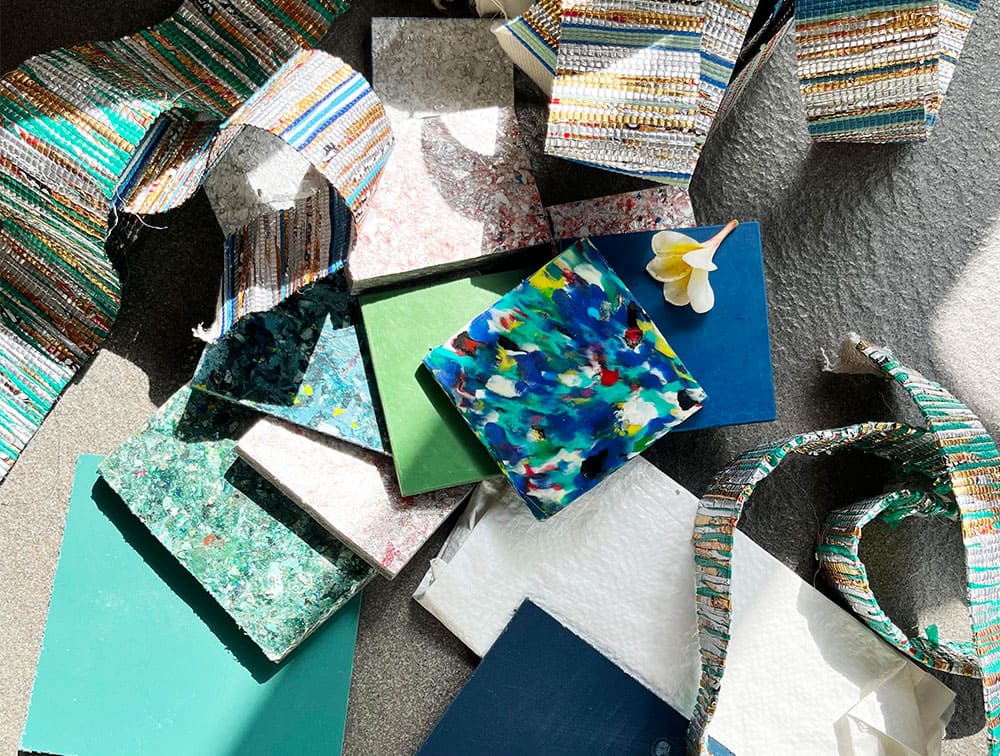Our mission and aim at WorkshopQ has always been to reduce waste by working with it. We choose the kind of waste we want to work with depending upon its availability, sustainability to use it and most importantly if upcycling contributes to adding value to it. We never really intended to restrict ourself one particular kind of waste like metal scrap, salvaged wood, cardboard, etc. Working with varied waste materials was exciting and helped us to challenge ourselves. Gradually, we pushed our boundaries to experiment how we could combine one waste material with another sustainable material to create something unrecognizable from its original source.
Recycled Plastic (Hard)
Hard plastics recycling refers to the collection and processing of rigid plastic items—often made from durable polymers like HDPE, PP, PS, ABS, and sometimes PET or PVC—into new products. These plastics are not flexible or film-like, and they’re typically used in consumer goods, packaging, and industrial applications. These waste plastics are shredded/granulated to get compressed into sheets and injection moulded products. They are extremely durable, sturdy and weather resistant. Lately, this has been our hero raw material to create public dustbins, trophies, furniture and store displays and sculpture pieces.
Recycled Plastic (Soft)
MLP (Multi Layer Plastics) and LDPE (Low-Density Polyethylene) are soft, flexible, and lightweight plastic with excellent chemical resistance and durability. They are one of the most common types of plastic used in packaging and consumer products like biscuit wrappers, plastic bags, squeeze bottles, bubble wrap, etc., but also one of the more challenging materials to recycle due to contamination and collection issues. We work with a craft organisation, Khamir based in Gujarat that employs its local community to collect waste plastic bags, wash them, cut them into strips and weave it into a beautiful fabric on a handloom. We used this fabric as a base with a Paithani pattern appliqued over it for an Art Installation at the Mumbai International Airport which went on to win the India’s Best Design Award at POOL design awards. Multi-Layered Plastic (MLP) waste refers to packaging materials made from multiple layers of different materials like plastic, paper, and aluminum foil, often used in food and snack packaging. MLP waste is a significant environmental concern because it’s difficult to recycle due to its complex structure and the challenges in separating the different layers. We transformed 1200 kgs of this discarded packaging waste into a 1900 square feet of wall mural handwoven by local artisans in UP.
Construction Debris
Construction debris waste, also known as Construction and Demolition (C&D) waste, refers to the materials generated during construction, remodeling, repair, and demolition of buildings and other civil structures. This waste includes a wide variety of materials, from concrete and wood to metals, bricks, and glass. In Mumbai, where there is a significant amount of construction activity, C&D waste is a major challenge, with the city generating over 8,500 tons daily. Our first tryst with construction debris was to make table top planters with a compound material of construction waste and gypsum. Working with an architect duo who developed this compound was a completely new learning experience for us. For an upcoming real-estate project in Pune, we created a series of 8 wall frames by using 100 kgs of construction debris (concrete, gravels, wood chips, shade nets, bricks debris and rubble) .
Metal Waste- Recycling metal waste into art, or upcycled art, involves creatively repurposing discarded metal materials into new artistic creations. This practice transforms items like old tools, car parts, and industrial scraps into sculptures, wall art, or functional decor. This form of upcycling not only showcases artistic talent but also promotes sustainability by reducing waste and giving discarded materials a new purpose. Having upcycled over 5000 kgs of metal waste till now into making 6 life-sized bird sculptures for the IIJS jewellery show, an armchair for an art collector’s plush bungalow in Alibaug , a woman’s face sculpture embodying power for Intellecap Advisory Services, a 6 feet tall Ganpati sculpture for Ford India, a 10 feet tall Transformer sculpture for Ashok Leyland using their redundant truck parts, our team of skilled metal artisans are nothing less than mechanical engineers. This journey of waste metal sculptures has been a continual learning, experimenting, exploring the wonders and challenges of using heavy metal auto parts. Giving these old, waste, redundant elements a new life in one sculpture is an artistically demanding yet a gratifying process.
Textile Waste
Textile waste ranks among the top 5 fastest-growing waste streams in the world, particularly due to Fast fashion overproduction, a decline in garment durability and an increase in synthetic fiber use. Using textile waste in art is an innovative, sustainable, and expressive way to address both environmental concerns and cultural narratives. With textile waste increasingly becoming the third largest source of waste in the world, only 12% of textile waste is recycled globally. Bunko Junko, a textile waste upcycler in Bombay which has empowered over 5000 women in their 25 year old journey. We worked with Bunko Junko to create a 15 feet wide wall mural for a conference room in a corporate office, with 10 kgs of textile waste hand-tufted into patterns resembling water ripples woven amongst stainless steel strips.
